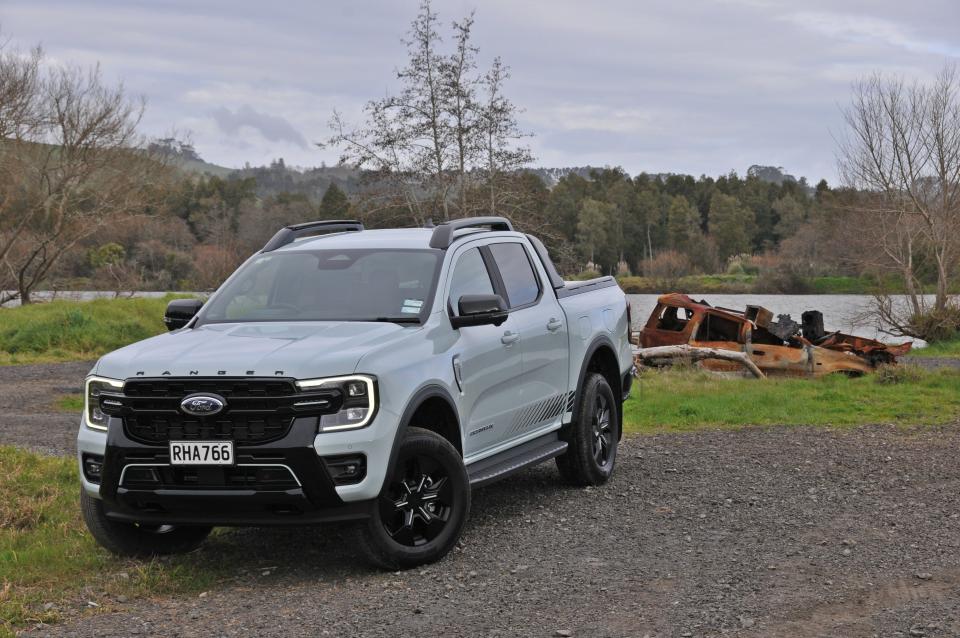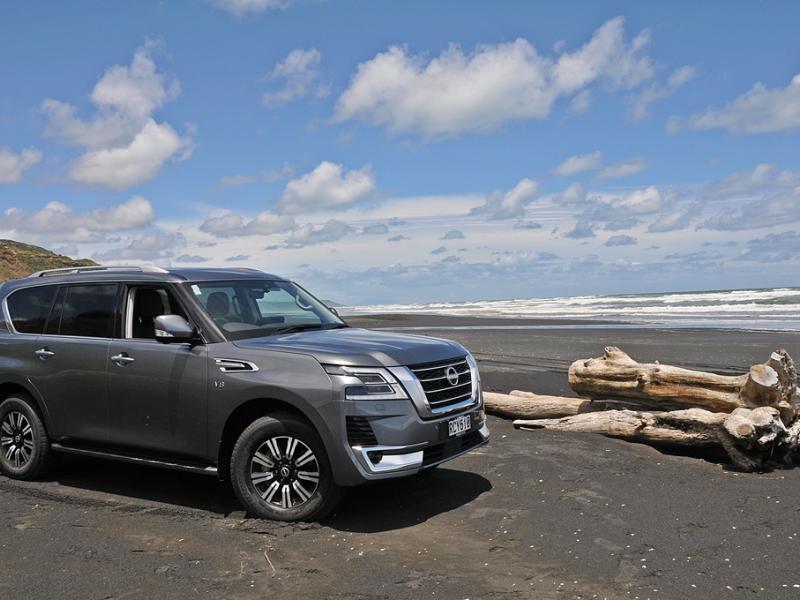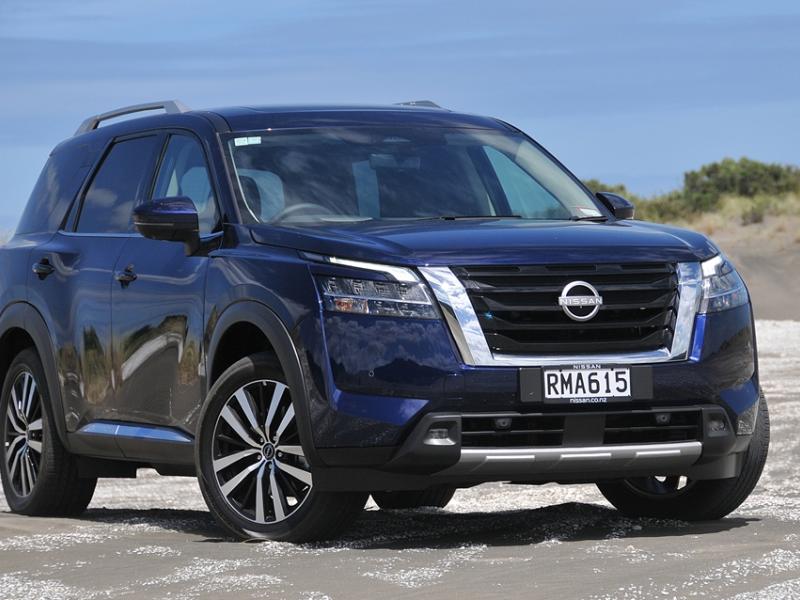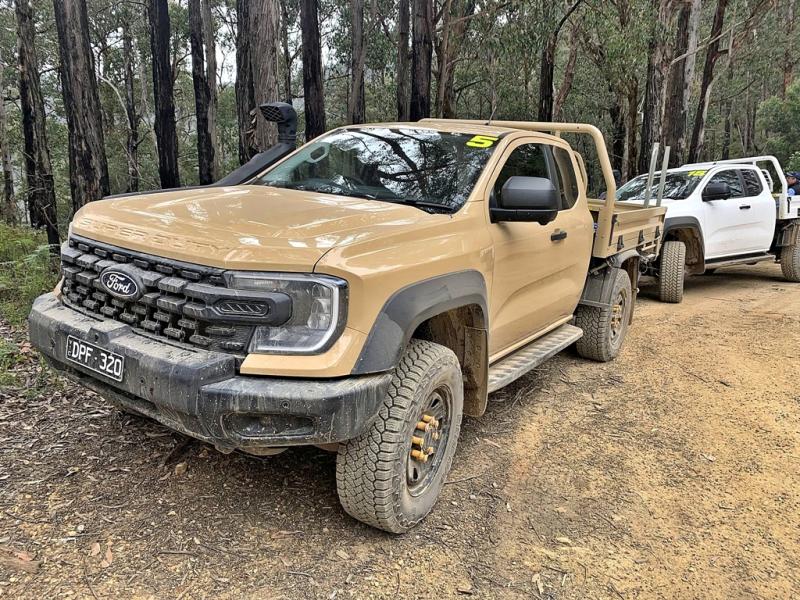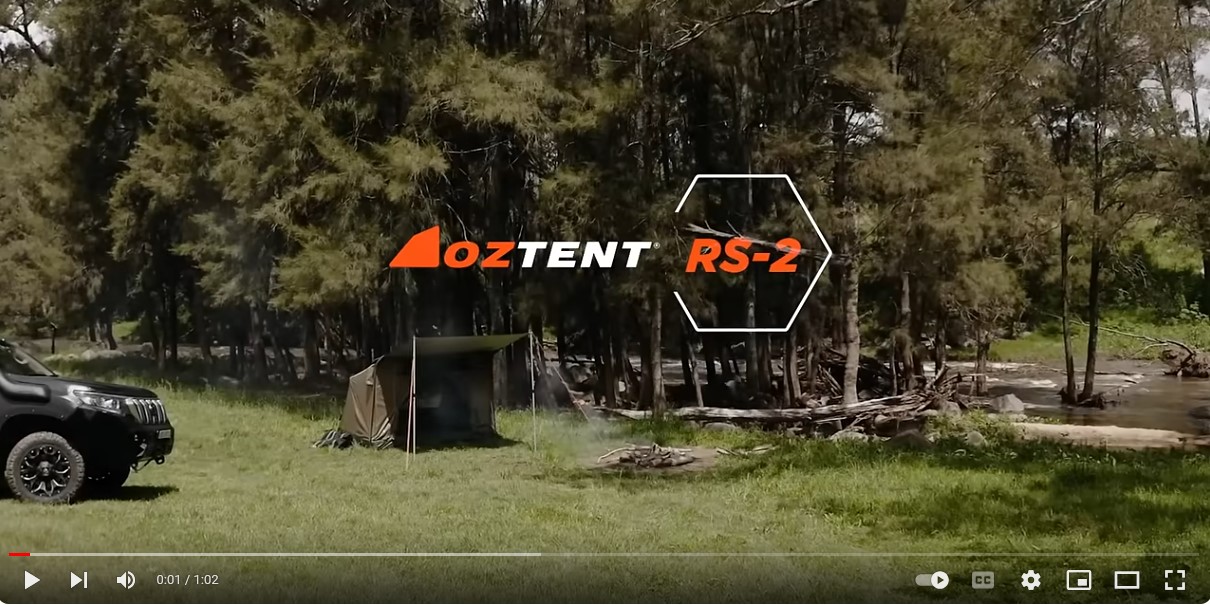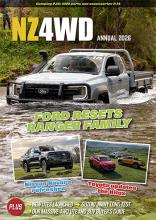This is the first New Zealand media drive of Ford’s new Stormtrak PHEV Ranger. Other scribes drove it overseas, but NZ4WD scored the first local test. Big thanks to good bloke Tom Clancy at Ford.
Ford is offering its plug-in hybrid technology across the XLT, Wildtrak and this, the PHEV flagship. Easy early recognition is the unique alloy wheel fitted to each version, XLT being 17-inch and the upper two being 18-inch. The tyres on our Stormtrak are 255/65x18 Continentals, and they are superbly matched to the vehicle's likely predominant use: urban and highway driving with a bit of offroad use. They did clog up on us twice - when trying to position a trailer-load of gravel on a steep, sloping Glenfield lawn (embarrassing), and in muddy tracks down Port Waikato way.
The Stormtrak uses a 4WD-tuned derivative of the Mustang's four-cylinder 2.3-litre turbo petrol engine as the basis for the powertrain, teamed with a 75kW electric motor integrated into the 10-speed automatic transmission. That fills out the Ranger engine range – previously, the 2.3 was only available in the platform-shared VW Amarok. It’s a superbly willing engine, and certainly an acceptable power unit for those who don’t want diesel – or the range-topping Raptor’s twin-turbo petrol V6.
Stormtrak is the heaviest Ranger at 2,695kg; thanks to its hybrid power train it has the most torque (697kW) and second-best power figures (207kW vs Raptor’s 292kW). All three models have this engine/hybrid combo.
Quoted fuel economy is 2.9l/100km. That is where the EV range is used to best advantage. Driving it as a regular hybrid, we got a real-world 8.2l/100km. This engine, minus hybrid gear and thus lighter in the Amarok, can only post 10.9 or so.
Also good: Stormtrak’s carbon emissions are quoted at just 64g/km.
The electric assist works in line between the engine and transmission. There are four modes to select from: EV Now, for full EV power; EV Auto, which decides how to apportion the fuel sources; EV Later, which saves the battery for later and prioritises petrol power; and EV Charge, which will make the engine act like a generator to top up the battery.
For Ford, this is the whole reason the PHEV version exists: it reduces the fleet-wide fuel economy stats, and even more importantly reduces its whole-of-fleet carbon emissions. Unfettered by global environmental requirements and objectives, buyers will find many other reasons to like the Stormtrak.
The interior of our Ranger Stormtrak has a distinctive design within the broader Ranger ‘family look’. There are some Chill Grey highlights inside, the seats are monogrammed, but largely, it's not much different to other high-spec Rangers.
No complaints there, it feels familiar and the Ranger still has one of the better interiors in the class when it comes to ergonomics, usability and practicality.
There are buttons and dials for air-con, volume and tuning, but those controls are replicated in the centre infoscreen as well.
There are pop-out cupholders near the vents, a super-configurable digital instrument cluster and the portrait style 12.0-inch touchscreen infomedia system with wireless smartphone mirroring tech, sat-nav, and much more.
There are menus on the screen to allow the owner to set up charging timers and even precondition the cabin to be cool or warm for those challenging midweek mornings, and other on-screen menus manage the Pro Power Onboard vehicle-to-load sockets in the tub (each outputting up to 3.45kW).
The screen can help turn the ute into a giant petrol-powered generator that will replenish the battery and keep things charged up, and beyond that there are menus to configure different components, plus a brilliant off-road view system with a forward-view camera to see what's ahead and where the vehicle is heading. That screen also allows the driver to trigger the electronic rear diff lock as well.
As always, comfort and convenience are a strong point, with cupholders between the seats, a reasonably large centre console bin, bottle holders in the doors, vanity mirrors with lights, and an overhead auxiliary switch bank, which could be great for adding accessories.
The driver’s seat is very good, with a decent level of recline to the backrest, and there are vents for those riding in the back too. It combines leather and suede inserts on the seat cushion which makes for great ‘feel’ and a sense of grip.
Device charging is sorted with a couple of USBs and a power point, phone charging is by inductive pad and there are also map pockets, a pair of cupholders in a flip-down armrest, and bottle holders in the doors.
The exterior of the Stormtrak is Ranger business as usual, with exceptions like the front guard ‘shield’ areas displaying PHEV logos and each door carrying the Stormtrak model name.
Tub depth is different for the PHEV models compared to the ICE versions due to battery placement under the tray, but still fits a ‘Euro’ pallet. This is noticeable when Stormtrak is available in the signature Chill Grey of our vehicle or Agate Black.
The tray has a sturdy metal roller cover for the tray and features a clever sliding ‘sailplane’ rack system for carrying long loads at roof level.
When the tailgate is lowered, there is a slight ramp about 250mm into the tray area. No big deal.
This is the first Ranger to offer the 2.3-litre EcoBoost turbocharged petrol four-cylinder engine. It makes 138kW and 411Nm; a relatively low state of tune for this very capable engine. Add on the 75kW electric motor sandwiched between the engine and 10-speed automatic gearbox and power is 207kW; torque is a whopping 697Nm.
VW got this engine for the top-end Amarok as part of the platform-sharing agreement; the addition of hybrid gear means this Ranger application develops more power and torque that the VW version.
In the default driver setting the transition from EV power at start-off to petrol power is smooth and simple. Ford says the Stormtrak’s 49km EV range should cover the daily needs of half their Ranger customers. We did use it in EV mode, but got around 35km of electric running before the truck needed to switch to petrol. Regenerative braking is a great function too, and the driver’s dash display will show how much energy has been recovered. There is also a ‘coach’ available to teach drivers how to make the most of the tech.
In default mode, we towed a couple of trailer loads of gap-20 gravel, about 1.8 tonnes in all, and saw 10l/100km at worst. On a mixed motorway/suburban route without a trailer we got 8.2/100 without really trying. The EV-focussed mode delivers an official 2.9l/100km - but that would be hard work for all but the most dedicated EV fan.
This is, however, the heaviest Ranger so far, by about 200kg. That weight is felt under braking sometimes, and we were a couple of days into our week with the truck before we stopped ‘feeling’ its mass. We think the battery being under the tray is very savvy. It doesn’t cause cargo-loading issues, and the weight does seem to damp suspension nervousness over choppy tarmac.
On sealed roads, acceleration was smart and effortless, and without the diesel growl of almost every other Ranger. For many buyers, that alone is a good reason to go the extra dollars for the PHEV.
The Stormtrak, Wildtrak or XLT PHEVs may also find their way onto fleets, where their EV economy and range and their low carbon emissions will help reduce a company’s overall carbon footprint. The government fleet managers may go for XLTs; the private sector (where users get to be choosers) will jump into a Wildtrak or Stormtrak.


